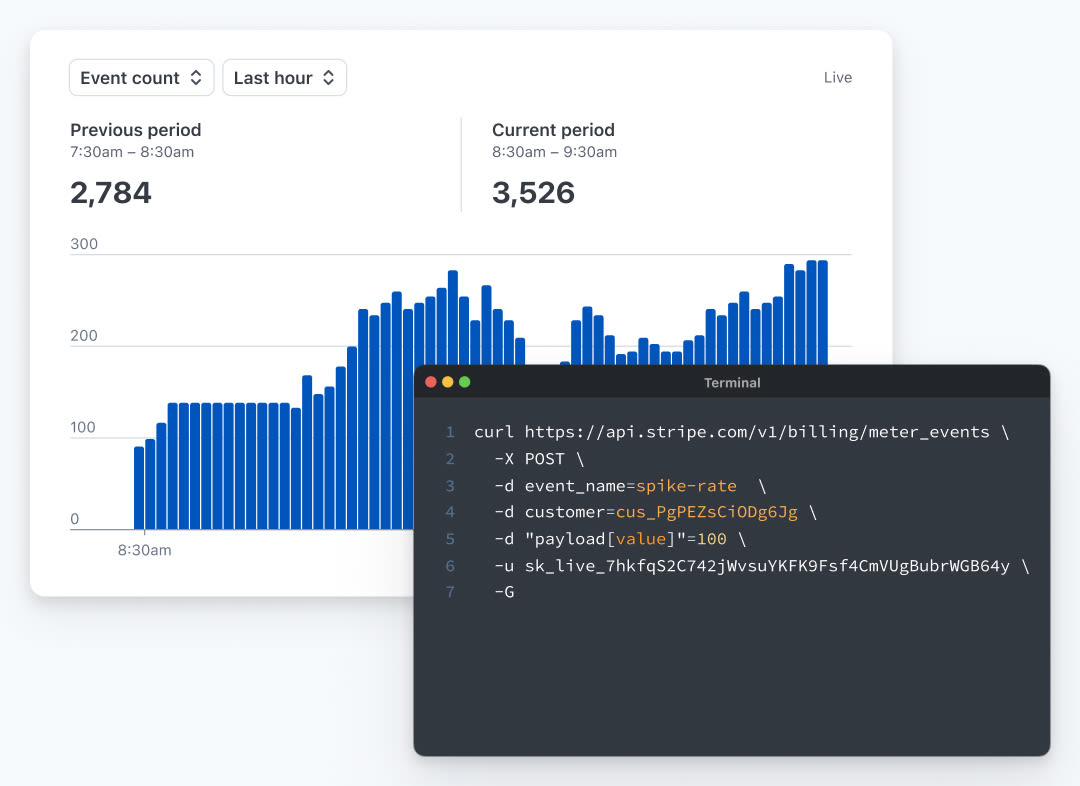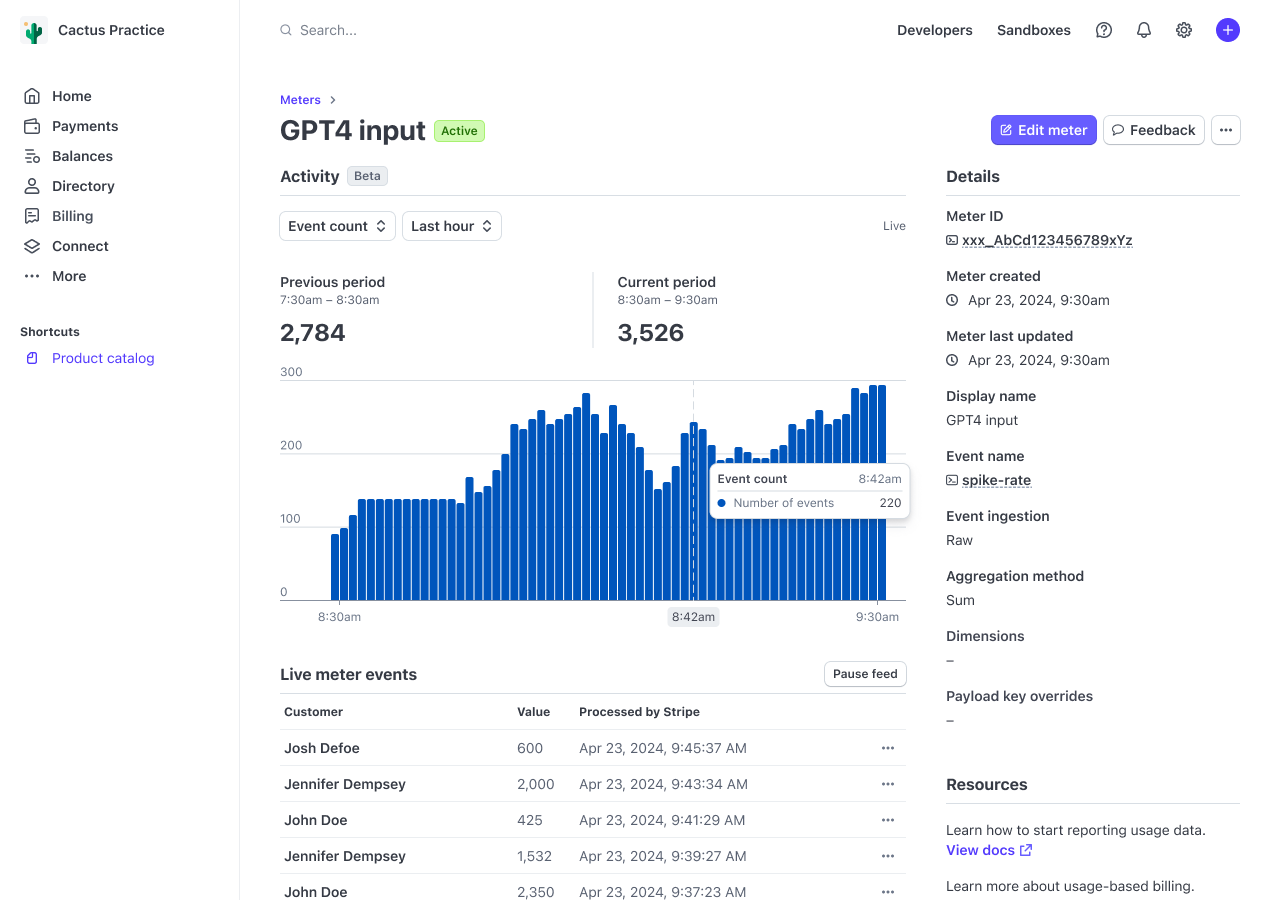Three ways our usage-based billing product is unique

Usage-based pricing has been used for years by infrastructure-as-a-service companies such as AWS, Snowflake, Datadog—and even Stripe. It lets you keep track of how much your customers use a product, and allows you to charge based on the actual cost of providing it. More recently, usage-based plans have become the preferred pricing model for AI companies, allowing them to align high-compute costs to value and price.
But what’s less noticed is how an increasingly wide range of companies are finding creative ways to bill for usage. In fact, virtually every part of the business-to-business (B2B) economy, and many parts of the business-to-consumer (B2C) economy, are enhanced by it. Just recently, we’ve seen:
- A customer support platform charging per satisfactory ticket resolution
- A digital security firm charging for each bug it catches
- A sales platform charging per email sent
That’s why in April at Stripe Sessions, we announced that Stripe Billing now supports usage-based billing with the new Meters API (now in GA), which features usage rate limits of 1,000 events per second. We also previewed plans to increase rate limits over the coming year.
Our usage-based billing product is built atop Stripe’s industry-leading reliability (with 99.999% historical API uptime) and integrates with Stripe’s broader product suite, including Billing and Payments. In this post, we want to share three ways our usage-based product is unique in the market—integrating naturally alongside your other billing pathways, while scaling with you as your usage-based pricing ambitions grow.
A single platform for every aspect of consumption pricing
Stripe Billing can now natively meter usage events, ingest data, bill users, and collect payments—all in the same place. You don’t need to build as many integrations, and you can worry less about connecting databases to support accurate billing, or using multiple payment gateways to meet the varying needs of your global customers. Stripe is the first and only usage-based billing solution that unifies every element of consumption pricing.
Responding to requests from Stripe users, we built the revenue and finance automation suite as an all-in-one platform for your business’s revenue pipeline. It includes Billing, Revenue Recognition, Tax, and reporting—and it lets you manage subscriptions, usage-based consumption, retention, revenue recovery, and payment processing all in one place. You can launch usage-based pricing, deliver the same user experience regardless of how your customers want to pay, calculate your tax obligations, and generate compliant accounting reports—all on a single system.
“Stripe gives us efficiency because everything is in one place—usage-based billing, subscriptions, invoices, payments data, outstanding balances, tax automation—and we don’t have to cobble data together or worry about incomplete data flowing between systems. Stripe gives me the comfort that we’ve got a complete picture of the customer and we’re getting standardization, automated reporting, and accurate data,” said Luke Franklin, controller at Retool.
Comprehensive real-time visibility
Stripe Billing ingests and analyzes usage data in real time, so you can provide your business and your customers with relevant insights as they happen. We know this real-time visibility into usage data is key: you can tell your customers how much they’ve used and when they’re approaching certain thresholds, plus you can slice and dice that data to make smarter business decisions. However, we also think visibility is only part of the story, especially if your usage-based billing data is disconnected from the rest of your business.
Because Stripe’s usage-based billing is natively integrated with Stripe Payments and also with most products in our revenue and finance automation suite (with the rest to follow later this year), we can provide you with comprehensive visibility into your revenue pipeline. The revenue and finance automation suite eliminates the need to manually combine data from disparate sources, so you can more easily identify bottlenecks, discover leaky funnels, and uncover sources of churn. You can unify every component of your revenue pipeline—metering, collecting invoices, recovering failed payments, and more—so you can make the best decisions for your business in real time.
“Stripe’s new usage-based billing support has been a great upgrade for us. Simpler code on our side is a huge win, and it made changing our pricing much easier. We love having everything billing related in one place and trust Stripe’s reliability to have all the numbers come out right. Stripe has the right abstractions to turn a complex or error-prone process into something we hardly have to think about. We know that we can grow, and that Stripe will scale right along with us,” said Jeff Dwyer, founder of Prefab.

A virtuous feedback loop
We’ve developed Billing and our broader revenue and finance automation suite to serve some of the most sophisticated billing users in the world: companies such as Atlassian and, more recently, pioneering AI companies such as Anthropic and Mistral AI. Building with these users in mind, we’ve been able to improve the product for Billing users of all sizes.
For example, Atlassian wanted a way to model pricing scenarios over time, so we developed test clocks, which enable Billing users to simulate future billing events in test mode. We think of this as the ultimate value of extensibility and scale: we’re helping the most forward-looking companies push the boundaries of their industries, and by doing so, we create tools and capabilities that we’re then able to extend to every Stripe user.
Building for the usage-based future
We see usage-based billing as more than just a pricing model—it’s a driver of long-term business transformation. That’s why in the near future, we’re going to be launching even more usage-based billing functionality. Coming soon, we’re aiming to deliver you:
- Increased rate limits up to 100,000 events per second
- Support for additional usage-based business models such as minimum commitments, rate cards, and credit burndowns, in addition to improved support for flat-fee plus overage plans
- Visualizations, thresholds, and alerts for real-time usage and spend
- Usage cancellation and correction
- Embeddable components to improve end customer experience, powered by our usage-based billing APIs
We want Billing to be configurable to support all your ambitions. With the Meters API that’s available now and the features we’re rolling out later this year, we’re getting closer to that goal.
Start configuring a usage-based billing meter in the Dashboard today, or read the docs to learn more.
